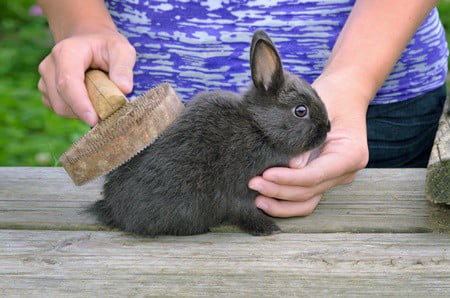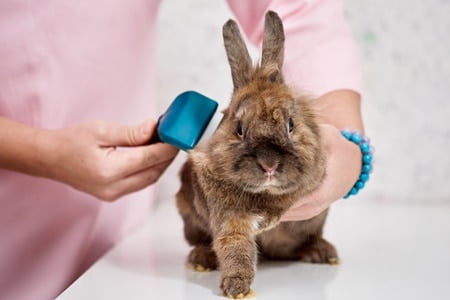A well-groomed rabbit is healthy and happy. Grooming involves brushing it, trimming it, removing mats, and getting rid of debris. Taking care of a rabbit’s fur requires close observation and checking for parasites so that you can seek immediate treatment if/when needed.
Brush the mat out first. For tougher mats, you may have to clip the tips of the fur before brushing the mat out. Try untangling the fur with your fingers without tugging on the fur. Some mats can be fleshy, so be careful with mats that are close to the skin to avoid injury.
Using a clipper head that is designed for the fine fur of a rabbit is the safest way to remove severe mats painlessly. If your rabbit is too matted, it may be best to have it clipped by a professional. In many cases, vets can provide this service or refer them to an experienced rabbit groomer.
How To Remove Mats from Rabbit Fur
Brushing your rabbit regularly is critical for its health. It also prevents difficult grooming issues that require expert attention, such as matted fur.
You can help your rabbit with its grooming by brushing it at least every three days. This doesn’t only remove loose hair, but it also prepares your rabbit for its daily brushings during heavy shedding seasons.
Where do Mats Occur in Rabbits?
Mats can occur anywhere on a rabbit’s body. However, there are some areas that are more susceptible to getting matted, particularly in long-haired rabbits. These include:
- Around the tail
- Under or around the chin
- On the belly
- Along the bottom sides of the body
- Between the front and back legs
- At the bottom of the feet
- Along the back end
How to Remove Severe Mats in Rabbits
If your rabbit is severely matted, you may have to get it clipped by a professional groomer. In many cases, rabbit-savvy vets can help owners with very matted fur or refer them to an experienced groomer.

Comb it Out
Do the following if you feel like you can treat your rabbit’s mats at home:
Body
Start by untangling the fur on a rabbit’s body with your fingers. Be careful not to tug on the fur as rabbits are highly sensitive, and the slightest pull can cause pain or injury to the skin.
Isolating the mat with your fingers can make it much easier to comb the problem area. Here’s how:
- Place your hand in between your rabbit’s skin and the mat and hold onto the matted fur.
- Then, you need to comb the fur a bit at a time to loosen the mats and remove any stray hairs.
Feet
When it comes to matted fur on the rabbit’s feet, remember that rabbits need the hair on their feet for protection.
However, the fur can get easily matted, especially if your rabbit doesn’t have a proper grooming routine. In most cases, the mats on the bottom of the feet can be pulled out.
You may notice that the fur on your rabbit has urine-stained fur on its feet and body. Follow the advice in this guide to remove any yellowing.
Neck and Chest
Most rabbits don’t tolerate being touched under the chin. If you’re trying to remove mats under your rabbit’s neck or chest, sweep the affected fur to the side of the face and brush it on the side to remove any mats.
Cut the Matted Fur
If mats are tough and you aren’t able to comb them out, the next best option is to cut them. You may cut your rabbit’s fur with scissors.
If you are using scissors, make sure you keep your hand against your rabbit’s body (between the matted fur and skin) so that you don’t accidentally cut the skin.
Matted fur can be very thick. What might seem like matted fur may be a combination of your rabbit’s skin and fur.
To prevent injury, you can also try cutting the tips of the matted fur only and combing the rest of the fur out gently. This may not necessarily work for severe or large mats, though.
You can also use a tool called a “mat rake” to separate the mats and clip them safely with scissors. However, some users find the tool awkward to use and prefer to use a regular comb or their fingers.
Should I Use Scissors or Clippers?
Electric clippers designed for fine hair, such as rabbit fur, are much safer than scissors. With scissors, you run the risk of accidentally cutting your rabbit’s skin, which may result in pain, injury and infection.
Experts recommend using 2-speed clippers. Anything less can burn out and not cut difficult mats properly. Single-speed clippers are only suitable for light use and often do not remove matted fur effectively.
While choosing blades, a #7 or a #10 blade works best for matted fur. If your rabbit’s mats are too tough, you may have to use a #30 blade. Keep in mind that a #10 blade or shorter will result in a “naked shave”.
For big mats, you’ll probably need more than a single session to completely get rid of the problem areas. Whether you’re using clippers or scissors, you’ll have to go slowly and carefully while being aware of where your rabbit’s skin is. Some owners may be able to completely remove all mats if their pet cooperates and stays still.
Mats on the rabbit’s feet should never be clipped down completely. Rabbits need this fur to protect their feet. Make sure you leave at least ¼ of the hair under your rabbit’s feet during grooming sessions. If you give your rabbit regular haircuts, avoid clipping the fur on your rabbit’s feet unless completely necessary.
If you’ve had to remove or clip larger mats on your rabbit’s feet, check its feet regularly to ensure the hair is growing back and that there aren’t any hock sores.
Reward Your Rabbit
Once you’re done, pat your rabbit and offer encouraging words to help it feel soothed and secure. If necessary, reward your rabbit with a malt-flavored hairball remedy, such as Petromalt.
During shedding season or when feces appears stringy, your rabbit may benefit from taking hairball medicine daily, or as recommended by a vet.
If your rabbit’s poop worsens, becomes smaller, doesn’t show signs of improvement or if your rabbit doesn’t poop at all, see your vet.
According to Veterinary Record, these are signs of a condition called GI Stasis. This can cause severe complications and death in rabbits.
Once your rabbit’s coat is healthy again, maintain a regular grooming schedule to prevent the accumulation of future mats.
The more often you brush your rabbit, the lower its chances will be of having tough mats. Regular brushing also reduces your rabbit’s risk of swallowing excess fur, which can result in digestive issues.
What Causes Mats in Rabbits?
The best way to prevent matted fur mats in rabbits is to understand what causes them in the first place. Apart from not brushing your rabbit regularly, some common causes of matted fur in rabbits include:
- Your rabbit is overweight. This prevents them from being able to clean their bottoms.
- Changes in your rabbit’s diet
- A drafty cage
- Damp and unkempt surroundings in the cage
- Lack of fiber in the diet
- Dental issues (common in dwarfs)
- Aging or joint problems/arthritis
How Often Should you Brush your Rabbit to Avoid Mats?
To keep your rabbit’s fur in good shape, you’ll need to brush it at least every three days. During shedding seasons, you’ll have to brush them daily.
Brushing your rabbit’s fur regularly keeps mats away and prevents your pet from swallowing excess fur. Swallowing too much fur can cause a rabbit’s digestive tract to slow down, potentially resulting in GI stasis.
Rabbits that shed quickly, such as long-haired rabbits, require immediate grooming to avoid illness. For Angora rabbits, grooming should be daily.
Unless you’re using them as show rabbits, long-haired rabbits can be trimmed regularly. In fact, they’ll prefer having shorter fur. Long-haired rabbits can be trimmed to a length of around 1 inch to prevent fur ingestion, blockages, and matting.
You’ll also want to make sure that your rabbit isn’t collecting any litter or hay in its fur which can cause matting.

